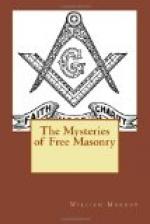names are Faith, Hope, and Charity; they teach us to
have faith in God, hope in immortality, and charity
to all mankind.” The Master to the Senior
Deacon, “You will now conduct the candidate out
of this Lodge, and invest him with what he has been
divested.” After he is clothed, and the
necessary arrangements made for his reception, such
as placing the columns and floor carpet, if they have
any, and the candidate is reconducted back to the
Lodge; as he enters the door, the Senior Deacon observes,
“We are now about to return to the middle chamber
of King Solomon’s Temple.” When within
the door, the Senior Deacon proceeds, “Brother,
we have worked in speculative Masonry, but our forefathers
wrought both in speculative and operative Masonry.
They worked at the building of King Solomon’s
Temple, and many other Masonic edifices; they wrought
six days; they did not work on the seventh, because
in six days God created the heavens and the earth,
and rested on the seventh day. The seventh, therefore,
our ancient brethren consecrated as a day of rest;
thereby enjoying more frequent opportunities to contemplate
the glorious works of creation, and to adore their
great Creator.” Moving a step or two, the
Senior Deacon proceeds, “Brother, the first
thing that attracts our attention are two large columns,
or pillars, one on the left hand, and the other on
the right; the name of the one on the left hand is
Boaz, and denotes strength; the name of the one
on the right hand is Jachin, and denotes establishment;
they collectively allude to a passage in Scripture,
wherein God has declared in his word, ’In strength
shall this house be established.’ These
columns are eighteen cubits high, twelve in circumference,
and four in diameter; they are adorned with two large
chapiters, one on each, and these chapiters are ornamented
with net work, lily work, and pomegranates; they denote
unity, peace, and plenty. The net work, from
its connection, denotes union; the lily work, from
its whiteness, purity and peace; and the pomegranate,
from the exuberance of its seed, denotes plenty.
They also have two large globes, or balls, one on
each; these globes or balls contain, on their convex
surfaces, all the maps and charts of the celestial
and terrestrial bodies; they are said to be thus extensive
to denote the universality of Masonry, and that a
Mason’s charity ought to be equally extensive.
Their composition is molten, or cast brass; they were
cast on the banks of the river Jordan, in the clay-ground
between Succoth and Zaradatha, where King Solomon
ordered these and all other holy vessels to be cast;
they were cast hollow; and were four inches, or a
hand’s breadth thick; they were cast hollow,
the better to withstand inundations and conflagrations;
they were the archives of Masonry, and contained the
constitution, rolls, and records.” The
Senior Deacon having explained the columns, he passes
between them, advances a step or two, observing as
he advances, “Brother, we will pursue our travels;




